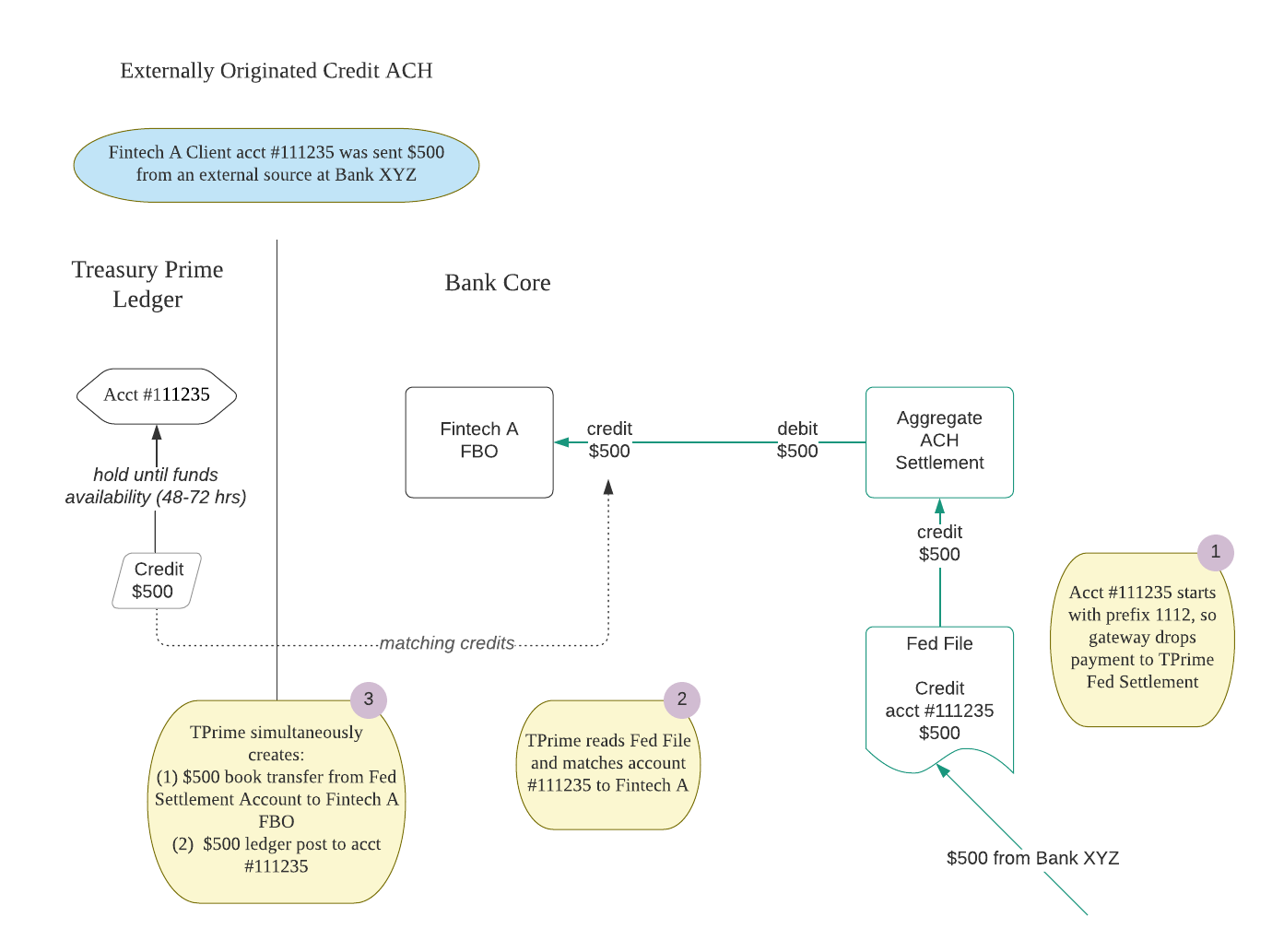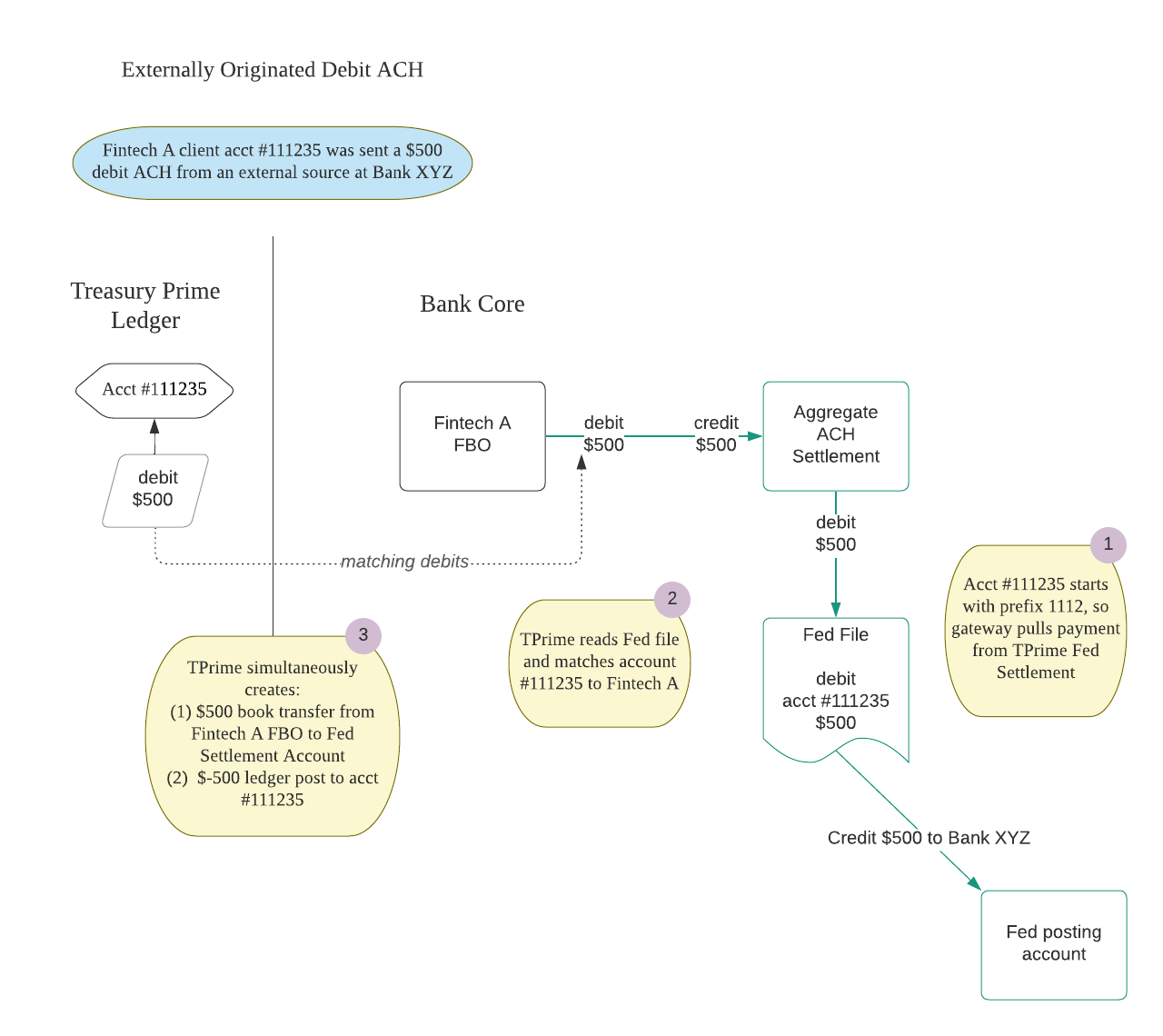Creating an ACH Transfer
Below is a sample request for creating an ACH transfer. For a more detailed overview of this process, please see the guide How to Transfer Funds Between Accounts Using ACH.Required Fields Explained
| Field | Description |
|---|---|
| account_id | For ACH credits, this will be the id of the account funding the transfer. For ACH debits, this will be the id of the account where the funds will be deposited. |
| amount | The amount of money to be transferred. |
| counterparty_id | The id of the counterparty receiving the transfer. For both credits and debits, the Counterparty will contain information about the account from which the funds will either be sent or debited accordingly. |
| direction | The value supplied in this field determines the direction of this ACH transfer (either credit or debit). |
| sec_code | The SEC code describes how a payment was authorized by the consumer or business receiving an ACH transaction. One of ccd, ppd, or web. |
Types of ACH Transfers
ACH supports two types of transfers: credit and debit. Also referred to as the “direction” of the transfer, the type of transfer selected determines whether the funds are pushed to a recipient’s account, or pulled from their account.ACH Credit
An ACH credit is used when you wish to send or “push” funds to a recipient. An example of an ACH credit transaction is payroll direct deposit, where an employer credits funds to an employee’s account.Lifecycle of an Originated ACH Credit
- A balance check is performed on the originating account to ensure sufficient funds are available to cover the transaction.
- The ACH object is created with an initial
statusofpending. - A hold is placed on the originating account to secure the funds for the transaction.
- The ACH
statustransitions toprocessing, the initial hold is released, and a withdrawal is made from the funding account. - The
statusof the ACH transitions tosentand the NACHA file containing the ACH is sent to the bank for processing. - Finally, the funds are deposited into the recipient’s bank account.

Note that the timing of status changes and funds availability varies by bank and by ACH service. See the the section on ACH timing below for more detail.
ACH Debit
An ACH debit is used when you wish to “pull” funds from an external account. Bill Payments, where a merchant is given permission to pull funds from their customer’s account, is one example of where an ACH debit might be used.Lifecycle of an originated ACH Debit
- The ACH object is created with an initial
statusofpending. - The ACH
statustransitions toprocessing. - The
statusof the ACH is updated tosentand thescheduled_settlementvalue is set. - The NACHA file containing the ACH is sent to the bank for processing.
- Finally, the funds are deposited into the originating bank account.

How Long Does an ACH Take?
The topic of how long it will take for funds to be received when sending an ACH is a bit complex and often ends in statements like “it depends”. To help clarify this, let’s look at the key factors that determine just how long it will take for the funds from an ACH to be received.Service Level
ACH supports two levels of service—standard and sameday—which ultimately determine how fast the ACH will settle. While the type of ACH (credit or debit), and the processes defined by the Receiving Depository Financial Institution (RDFI) also play a role in settlement time, the general timelines for standard and sameday ACH processing are as follows:
| Service | Settlement Time |
|---|---|
| Standard | 1-3 business days |
| Sameday | 0-1 business days |
Note that ACH transactions are only processed during business banking days, so you will need to keep this in mind when assessing transfer timelines.
Submission Time
As a matter of practice, ACH transfers are processed in batches by the ODFI (Originating Depository Financial Institution) at set intervals throughout the day. The times at which these batches are processed, known as “processing windows,” are defined by each ODFI, so it is recommended you speak with your Customer Success Manager or Bank Partner(s) to understand the specific timings defined by your partner bank(s). It’s also worth noting that there are separate processing windows for standard and sameday ACH transfers. In order for an ACH to be included in a specific processing window, it needs to be submitted prior to the cut-off time for that window. Treasury Prime defines cut-off times as being 30 minutes prior to the scheduled start of the processing window. To bring this all together, let’s look at the example of a made-up ODFI, Prime Bank.Prime Bank ACH Processing Windows
| Processing Window | Cut-off Time | Service |
|---|---|---|
| 11:30 | 11:00 | sameday |
| 12:30 | 12:00 | sameday |
| 5:30 | 5:00 | standard |
Direction
The direction of the ACH also plays a role in determining how long the transfer will take to complete. Specifically, ACH debits tend to take a bit longer than their credit counterparts. Let’s take a quick look at why this is, and how it affects ACH processing. As it is unknown whether sufficient funds will be available in the account when an ACH debit is initiated, there is an additional level of potential fraud risk introduced in this type of ACH payment. To counteract this, and aid in fraud prevention, ACH debits include a delayed settlement period (imposed by the ODFI) prior to releasing funds to the recipient’s account. This delay provides the RDFI an opportunity to fulfill the debit request and, if necessary, respond with an error. While the length of this delay can vary de on the arrangements made with your bank partner, funds forsameday ACHs are generally released to the recipient after 48 business hours, and standard ACHs after 72 business hours.
For ACH debit transfers originating from Treasury Prime ledger accounts, the ACH object will be populated with a scheduled_settlement value defining when the funds are expected to become available in the recipient’s account. This value is set when the ACH reaches a status of processed and will take into account the service level selected and any other variables involved in the ACH settlement timing.
Limits on Total ACH Transaction Amounts
A set of velocity limits exists for debit and credit ACH transfers which limit the total dollar amount that can be transacted for each transfer type within a rolling 24-hour period. These limits are defined by your bank partner and can be adjusted with approval from the bank. While separate limits exist for debit and credit ACHs, there is no differentiation among service levels, so both sameday and standard ACHs will count against the daily limit for each type. The timestamp supplied in thecreated_at property of the ACH object is used to determine which transactions are included within the rolling 24-hour limit. Canceled ACH transactions do not count toward this limit.
What Data Will Be Shown to ACH Recipients?
The short answer to this question is “it depends”. There are a number of parties involved in the processing of ACH transfers, and each plays a role in determining what information is or is not displayed to the end user. For ACH transfers initiated on the Treasury Prime platform, thedescription and addenda fields are passed with the transaction; however, whether this information is displayed to the recipient is solely up to the RDFI. As shown in the example below, the recipient of the ACH might see “Test ACH” show up in their banking application, or they might not. It’s up to the RDFI.
Monitoring the Status of an ACH
Thestatus field of the ACH object represents the current status of the ACH transfer. You can monitor changes to this status (and thus the processing of the ACH) by subscribing to the ach.update webhook. It’s important to note that unless an ACH is returned or encounters an error during processing then sent will be its terminal status. This is because the ACH network does not support sending updates to confirm the receipt of funds or the successful completion of a transfer after it has been sent for processing. If an error is encountered or an ACH is returned, then the status will be updated accordingly. Otherwise, a successful ACH will end in a status of sent.
Canceling an ACH
An ACH originated on the Treasury Prime platform may be canceled while it is in astatus of pending. Once the ACH transitions from pending to processing, then it may no longer be canceled. To cancel an ACH, update its status to canceled as outlined below.
pending ACH can also be done directly in the Treasury Prime Dashboard app for users with the required permissions.
Identifying Transactions Related to an ACH
There are two fields that are used to map an ACH to the related transaction(s) that are generated as part of the payment flow. The first,trace_id, can be used to surface all transactions related to a particular ACH (including hold, hold_release, withdrawal, and deposit transactions).
The second field, ach_id is used to identify only transactions that resulted in the movement of funds (a withdrawal or deposit). For transactions that did not result in funds movement (such as a hold, or hold_release) the ach_id field will be null.
Note that the values for both of the
trace_id and ach_id fields will be the id of the originating ACH object.Example ACH Debit and Resulting Transactions
Let’s run through an example of what transactions might result from the creation of an ACH. Say you create an ACH debit for $100 and you get the response below, including itsid of “ach_1234”.
deposit, a hold, and a hold_release. Reviewing these three transactions, we can see that:
- The
deposittransaction (which deposits $100 into the account) contains both atrace_idandach_ideach with the same value of “ach_1234”. - The
holdandhold_release(which do not result in funds movement) have atrace_idof “ach_1234”. In all three instances, the value “ach_1234” matches theidthe originating ACH, allowing us to map these objects.
Returning Related Transactions Via the API
To find the transactions related to an ACH, you can use the/transaction endpoint to return all transaction results, then filter on either trace_id or ach_id depending on which result set you are looking for. In both cases, the value supplied will be the id of originating ACH (ex: ach_1234).
Filtering Transactions by trace_id
This will return all transactions that are related to ach_1234:
Filtering Transactions by ach_id
This will return only transactions that rsesulted in the movement of funds from ach_1234:
The Resulting Transaction Details
The deposit Transaction
This first transaction deposits funds from the ACH debit into the originating account.
ach_id = “ach_1234”
trace_id = “ach_1234”
The hold Transaction
This transaction places a hold on the newly deposited funds. This will remain in place until the transaction has been fully settled.
trace_id = “ach_1234”
The hold_release Transaction
This transaction fully releases the prior hold, making the funds deposited from the ACH fully available to the account holder.
trace_id = “ach_1234”

